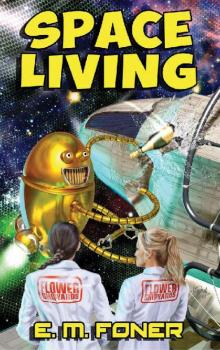- Home
- E. M. Foner
Space Living (EarthCent Universe Book 4) Page 16
Space Living (EarthCent Universe Book 4) Read online
Page 16
“I’m not sure that Samuel will be willing to negotiate with all of the Wanderers on behalf of the Human Empire,” Flower said. “He’s been reticent to take any major decisions before their Stryx-approved mentor arrives. A modest payment that would strike any of us as a bargain to see the Wanderers off will likely seem like an enormous amount to such a young man.”
“His wife is from one of the wealthiest Human families on the tunnel network,” M793qK said. “She’ll be able to help him put things into perspective. And my sources tell me that the Human Wanderers are still treated as second-class citizens for the very reason that they don’t strike fear into their own species because of Earth’s immunity from the mobs. I believe they would rather come out of this with honor than money.”
“By your sources, you mean the Zarents,” the Grenouthian director said. “I’m not aware of any Farlings running with Wanderer mobs.”
“What difference does it make where his information is from as long as it’s accurate?” Jorb added the remainder of the hot dipping sauce to his drink and stirred it in while he spoke. “I’ve been friends with Samuel and Vivian for years so I’ll explain the situation to him. I’ll suggest that he come up with something flashy to offer the Human Wanderers, like meaningless diplomatic titles.”
“Humans put great store in honorary doctorates from universities,” Brynlan said. “I’ve read that in the century before the Stryx opened Earth, dictators prided themselves as much on their doctorates as their military ranks.”
“I don’t know if Samuel has access to any universities,” Jorb said and glanced up at the ceiling.
“Don’t even think it,” Flower told them. “I have the only Open University campus not run by a Stryx librarian and I’m not going to risk that by handing out fake degrees.”
“I’m sure we have enough universities of our own back on Earth that could supply what the Human Empire needs,” Bill said. “In the city where I grew up, it seemed like there was a college on every other block, though none of them had many students.”
“What else do Humans respect?” Brynlan asked him.
“I didn’t really have any experience with high society on Earth,” Bill said. “I was just a street vendor with my mom. I guess that people cared a lot about clothes. You could sort of tell what class people came from by what they were wearing.”
“Maybe a bespoke suit then,” Jorb suggested. “What else?”
Bill didn’t want to say that he’d thankfully forgotten most of his life on Earth, so he rooted around in his memory. “People like to be seen with celebrities,” he said. “I remember that all the restaurants had a display panel in the window showing images of the owner with famous people who had come in to eat.”
“Did the celebrities eat for free in return for getting their picture taken?” the Grenouthian director asked.
“I don’t know. But I remember now that important people also had fancy floaters, with somebody who sat in the front and opened the door for them, even though the floaters drive themselves.”
“That’s a good pitch for getting the Wanderers to board now that Flower has transferred ownership of the Miklat,” Razood said. “Samuel just has to convince them that the Zarents are chauffeurs.”
Fifteen
“You only have ten minutes before the Zarents arrive at my shipyard,” Flower told Julie. “The scale model will still be here when you get back.”
“But I almost have it this time. It’s just the nose that doesn’t want to fit right.”
“Given the quality of the scale model and its lack of sentience, I suspect the problem lies elsewhere.”
“There,” Julie said triumphantly as the nose suddenly settled into place. “Under two hours and I didn’t have to ask anybody for help. I’ll just grab my purse and—Noooooo!”
“Did you hurt your back?” Flower asked. “My infrared imaging shows you frozen in an awkward position.”
“I just spotted a piece on my desk that got left out,” Julie reported mournfully. “It’s the secondary cooling module. I remember now that I set it aside while I was putting together the primary cooling components so I wouldn’t get the two subassemblies confused. Then I got caught up in replacing all of the cargo hold deck plates over the technical deck crawl space and I completely forgot about the secondary system.”
“If you were repairing a ship underway and you had to shift cargo around, it would be standard procedure to remove the minimum number of deck plates required to gain access. But when you’re assembling ships in a factory, you should delay installing any deck plates until you’ve done the final inspection and checked the cooling system for leaks.”
“But it’s a model, it doesn’t actually function,” Julie protested as she headed for the exit.
“The principle still stands,” Flower said. “You’ve come a long way, from not being able to tell a fuel pack from a microwave oven, to easily identifying all of the primary components of a two-man trader. The final stage is mastering the order of assembly rather than trying to piece the model together like a jigsaw puzzle.”
“But nobody ever taught me the order.”
“That’s because I wanted you to see how far you could get on your own,” the Dollnick AI said. “If I had given you the manual at the beginning, you would have followed the instructions without paying close attention to the relationships between the parts and the logic of ship construction.”
Julie entered the lift tube capsule and it immediately began moving without waiting for her to give a destination. “You’re telling me there’s a manual?”
“Of course there’s a manual. I just sent it to your tab.”
“Is this how Dollnicks teach engineering? Just give the students a model and tell them to take it apart and put it together again until they get it right?” Julie scowled when Flower didn’t answer immediately. “I know when you hesitate like that it’s because you’re trying to decide whether or not to tell me something. Were you just checking with your Stryx mentor?”
“I wanted to give it a little thought, and my game-master duties for the LARPing studios are cutting into my spare capacity. I should have postponed building the second one until after the Wanderers left, but it seemed like the easiest way to keep them out of trouble.”
“Bill told me that he and Jorb tried getting in to LARP at least three times last week but the lines were always too long,” Julie said. “I don’t understand how the Wanderers can spend so much time just playing in virtual reality. Don’t they get tired of killing things?”
“Apparently not, but the real mystery is the enthusiasm with which they’ve taken to crafting.”
“That means making things in the game, right?”
“Basically light manufacturing, but also gathering materials, farming, and construction,” Flower said. “All of the work-related activities they refuse to engage with in real life they’ve embraced in virtual reality for the sake of earning in-game currency, level bonuses, and skill points. It makes no sense at all.”
The capsule doors opened and Julie spotted Laura and Don waiting by the freight lift tube at the next spoke ring further up the deck. She shifted from speaking out loud to subvocalizing and began walking across the largely empty factory floor.
“So the Wanderers are willing to work as long as they’re playing a game?” Julie asked. “That’s one of the weirdest—hey, you changed the subject on me. What happened to answering my question about how Dollnicks teach engineering?”
“Learning the names of spaceship parts and how they fit together isn’t exactly engineering,” Flower said after another hesitation. “Do you remember what the Zarent chief engineer told you about their little apprentices and Sharf two-man traders? It’s the same with Dollnicks, though we use colony ship models.”
Julie stopped short, and when she started walking again, her stride was stiffer than before. “You’re saying I just spent weeks struggling to do something that Dollnick children learn on their own before they even star
t their formal schooling.”
“Don’t be angry, Julie. If you had attended a nursery school where there were scale models of spaceships to play with, I’m sure you would have mastered the fundamentals in no time. It’s not a competition, you know.”
“Isn’t it? You’re always telling me that interspecies business competition is a substitute for war.”
“The Zarents will be arriving in thirty seconds.”
“We’ll finish this later,” Julie said, and then jogged the rest of the way to the freight lift tube.
She barely had time to greet Laura and Don before the doors slid open and a half-dozen Zarents on unicycles pedaled out. They were accompanied by twice their number of four-armed maintenance bots that were a bit smaller and blockier than Flower’s standard model, but despite the obsolete design, they were as shiny and free of dings as if they had just been manufactured.
“Greetings,” the chief engineer said, tilting his unicycle towards the reception committee. “Flower invited us to test a few of the bots she’s reconditioned while we help you put together your assembly line.”
“Thank you for volunteering your time,” Laura said.
“We did a barter deal,” the Zarent informed her honestly. “And I want to congratulate you on the adequacy of the work you performed on the Miklat.”
“Uh, thank you,” Laura said, doing a little head bob in response to the Zarent’s tilt. “None of us had any experience working on old Dollnick colony ships so we just did what Flower told us.”
“The ability to follow instructions is the first rotation on the path to enlightenment,” the chief engineer told them. “The lift tube capsule will be returning with more of my engineering staff and another batch of bots in a few minutes, so why don’t you show us where you want the assembly line.”
“Don’t you need to see all of the machinery first?” Don asked.
“We’ll sort it out as we go. Flower provided us with the seller’s imaging of the assembly line before it was broken down for shipping. The Sharf practice a form of just-in-time production where each station on the assembly line is responsible for manufacturing the parts it contributes to the finished product.”
“Do you mean that the machines that stamp out hull parts are located right next to the assembly line station where they’re welded together?” Don asked. “I worked on an assembly line in a manufactured home factory one winter, but all of the parts and subassemblies arrived on trucks from other locations.”
“Sounds terribly inefficient,” the Zarent said. He pivoted on his unicycle to look in the direction that one of his engineers was pointing with a tentacle. “Fourth Engineer Miklat tells me that the white tape on the deck corresponds to the rough dimensions of the assembly line in the Sharf imagery.”
“Don and I used those images for the layout, but we aren’t very confident in the results,” Laura said. “Our next step was going to be arranging all of the parts we have—” she waved her arm at the mounds of Sharf machine components surrounding the lift tube, “—in accordance to where they appear in the pictures, but then Flower decided our time would be better spent learning something about repair work on the Miklat.”
“I approve of your strategy and I’m saddened that you were unable to pursue it while engaging in work that we left undone,” the Zarent said, and the whole group of engineers dipped their unicycles in apology. “Now, which end do you want the ships to come off?”
“We hadn’t gotten that far yet. To tell you the truth, we’re a little worried about whether the finished ships will even fit the vertical space in here.”
“But we assumed Flower already knows they will or she wouldn’t be doing any of this,” Don added.
Everybody turned to look at Julie.
“Just a minute.” She pointed at her ear and subvoced, “What do I tell them?”
“The ships will come off the assembly line lying on their sides, and there’s ample room between decks,” Flower replied. “We discussed all of this last week and you said you understood.”
“I was trying to figure out how the fuel pack connected to the main drive in the scale model and I was just agreeing so you’d stop distracting me,” Julie subvoced back, and then continued out loud. “Flower says that you’ll assemble the ships lying on their sides.”
“But unless there are different capsules for the freight lift tubes than the ones we’ve been using to deliver cabins to the writers colony, we’ll never get the finished ships out of here without cutting them in half,” Don said. “Is there a larger capacity lift tube, or an empty shaft somewhere else on the deck?”
“All of the decks have full-height exterior hatches at the midpoints between the spokes,” Julie said, dredging her memory for details of the plan Flower had laid out. “That’s why if you look at a colony ship end on, even if the transparent parts of the hull are all lit up from the inside, you’ll see dark lines in the same pattern as the spokes.”
“So are we going to have to evacuate the deck every time we’re ready to launch a ship?” Laura asked.
“Flower has an atmosphere retention field in place around her whole structure, and she’ll have a portable backup field that functions like an airlock installed before the first launch. So I guess it makes sense to have the finished ships come off the assembly line as near to the end of the ship as possible.”
“In line with the midpoint between spokes,” the chief engineer added. “That’s exactly where I would have put it myself for structural reasons. So let me and my crew bot up and we’ll get started.”
“Bot up?” Don asked.
“In designing us, the Farlings had to make many tradeoffs, and one of them was giving us a small form factor so we can work in geometrically complex spaces. While we are much stronger than Humans on a size-adjusted basis, moving massive objects with tentacle power alone is not our specialty. We all practice with servomechanisms from a young age, and Flower has graciously programmed these bots with a servo-mode.”
The Zarents set down their unicycles, and then moving on their tentacles, approached and mounted the floating bots. What Julie had taken to be the blocky external battery of a previous generation actually unfolded into a servo controller. The little aliens slipped into the saddles and inserted a tentacle into each of eight flexible tubes. Then they performed some calibration exercises, matching the movement of the mounted bot’s arms to that of their individual tentacles, and then repeated the calibration process for a companion bot without a rider.
“Eight tentacles to fully control two bots,” Don said, looking envious. “Pretty slick. But how can you see what the second bot is doing?”
“In addition to telepathy, we have a biological interface for electromagnetic radiation in the useful part of the communications spectrum,” the chief engineer explained. “Flower has equipped the bots with transceivers that operate in our sweet spot.”
Six more Zarents accompanied by a dozen bots emerged from the lift tube, and this group immediately fanned out among the mounds of Sharf equipment.
“I’ve instructed my junior engineering staff to start putting together the basic magnetic levitation conveyer system that the assembly line is built around,” the chief engineer continued. “My team will begin building the manufacturing stations.” He seemed just as comfortable riding a floating bot as he had been pedaling his unicycle, and Julie found herself having to break the occasional step to keep up.
“Will we be getting in the way if we watch?” Laura asked.
“Not at all,” the Zarent assured her. “I only hope you aren’t so bored that you fall asleep. When moving and assembling massive pieces of machinery, the secret is to go slowly.”
“We had an expression in the building trade—measure twice, cut once,” Don said. “We still ended up with a lot of waste. Do the Zarents have any sayings like that?”
“If at first you don’t succeed, your initial plan was defective,” the chief engineer recited in a sing-song through his speaking device. �
��We’re trained from an early age not to waste our efforts in bumbling towards a solution.”
After that, the three humans hung back and watched the twenty-four bots controlled by the twelve Zarent engineers as they deftly began fitting together the components of the assembly line. Julie witnessed the two bots under the chief engineer’s control joining the halves of what looked like some sort of motor that had metal alignment dowels as long as her thumbs protruding from one side of the casting. No last-minute adjustments were necessary—the bots approached each other with the heavy motor halves held firmly in four arms, and the alignment dowels slid right into the holes.
“I couldn’t do that with a single bolt and a washer in one try,” Don muttered to the two women. “I hope operating this equipment doesn’t require that level of hand-eye coordination.”
“Don’t worry about it,” a scratchy voice behind them said, and they turned to see that the Sharf spy had joined them. “The Zarents are in a class of their own when it comes to fine control over their appendages.”
“Yaem,” Julie greeted the skeletal alien. “What are you doing here?”
“Dropping off this tab with my translation of the operating instructions for the assembly line. Flower supplied the tab so I don’t need it back.”
“You did the translation yourself? I thought Flower only needed your help with the old engineer’s handwriting.”
“It was no more work to do both at the same time, and it gave me a chance to improve my technical Humanese,” Yaem said. “It’s odd how your species has a different vocabulary for each specialty rather than using the same words for everything. I suppose it has to do with professional guilds protecting their turf.”

 Last Night on Union Station (EarthCent Ambassador Book 16)
Last Night on Union Station (EarthCent Ambassador Book 16) Empire Night on Union Station (EarthCent Ambassador Book 18)
Empire Night on Union Station (EarthCent Ambassador Book 18) Space Living (EarthCent Universe Book 4)
Space Living (EarthCent Universe Book 4) Review Night on Union Station (EarthCent Ambassador Book 11)
Review Night on Union Station (EarthCent Ambassador Book 11) Assisted Living
Assisted Living Con Living
Con Living Freelance On The Galactic Tunnel Network
Freelance On The Galactic Tunnel Network Career Night on Union Station
Career Night on Union Station Career Night on Union Station (EarthCent Ambassador Book 15)
Career Night on Union Station (EarthCent Ambassador Book 15) Word Night on Union Station (EarthCent Ambassador Book 9)
Word Night on Union Station (EarthCent Ambassador Book 9) Soup Night on Union Station
Soup Night on Union Station Human Test
Human Test Spy Night on Union Station (EarthCent Ambassador Book 4)
Spy Night on Union Station (EarthCent Ambassador Book 4) Family Night on Union Station (EarthCent Ambassador Book 12)
Family Night on Union Station (EarthCent Ambassador Book 12) Party Night on Union Station (EarthCent Ambassador Book 10)
Party Night on Union Station (EarthCent Ambassador Book 10) Turing Test
Turing Test Alien Night on Union Station (EarthCent Ambassador Book 2)
Alien Night on Union Station (EarthCent Ambassador Book 2) Wanderers On Union Station (EarthCent Ambassador Book 6)
Wanderers On Union Station (EarthCent Ambassador Book 6) Vacation on Union Station (EarthCent Ambassador Book 7)
Vacation on Union Station (EarthCent Ambassador Book 7) Book Night on Union Station (EarthCent Ambassasor 13)
Book Night on Union Station (EarthCent Ambassasor 13) LARP Night on Union Station
LARP Night on Union Station Carnival On Union Station (EarthCent Ambassador Book 5)
Carnival On Union Station (EarthCent Ambassador Book 5) LARP Night on Union Station (EarthCent Ambassador Book 14)
LARP Night on Union Station (EarthCent Ambassador Book 14) Book Night on Union Station
Book Night on Union Station High Priest on Union Station (EarthCent Ambassador Book 3)
High Priest on Union Station (EarthCent Ambassador Book 3) Meghan's Dragon
Meghan's Dragon Human Test (AI Diaries Book 2)
Human Test (AI Diaries Book 2) Guest Night on Union Station
Guest Night on Union Station Date Night on Union Station
Date Night on Union Station